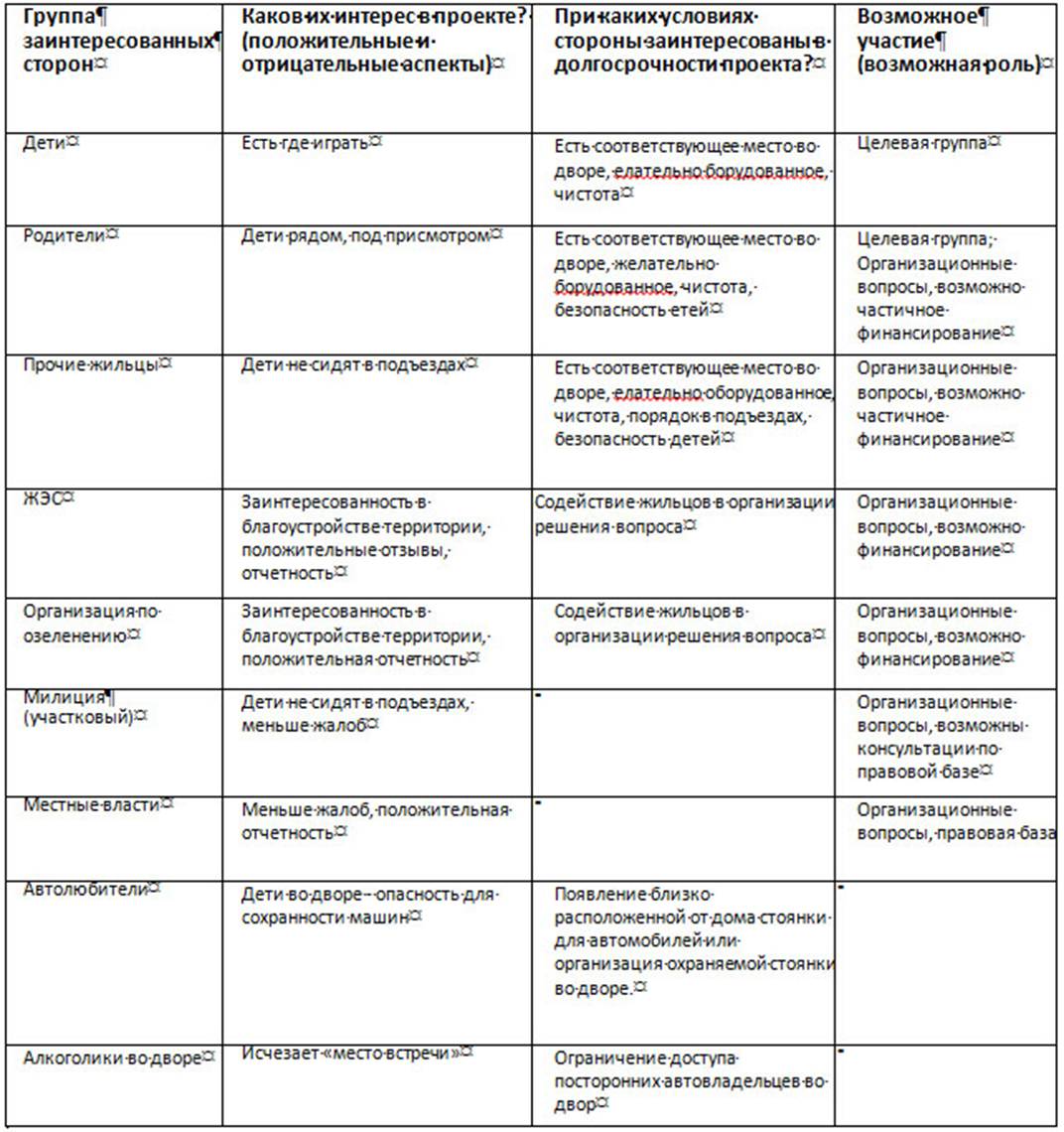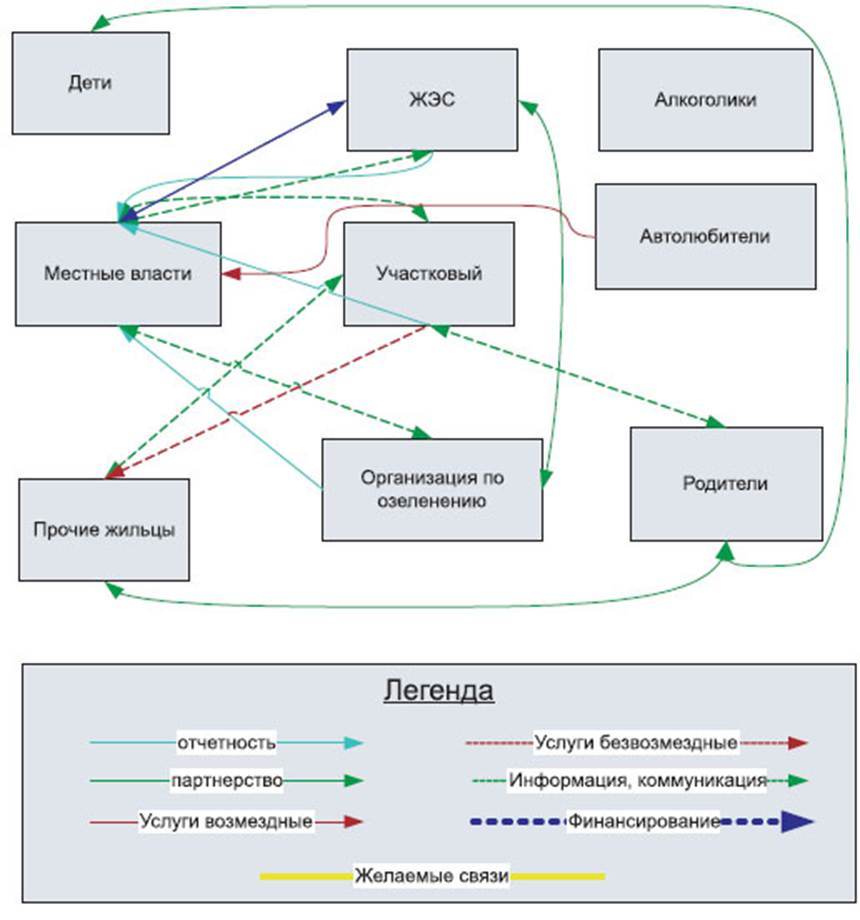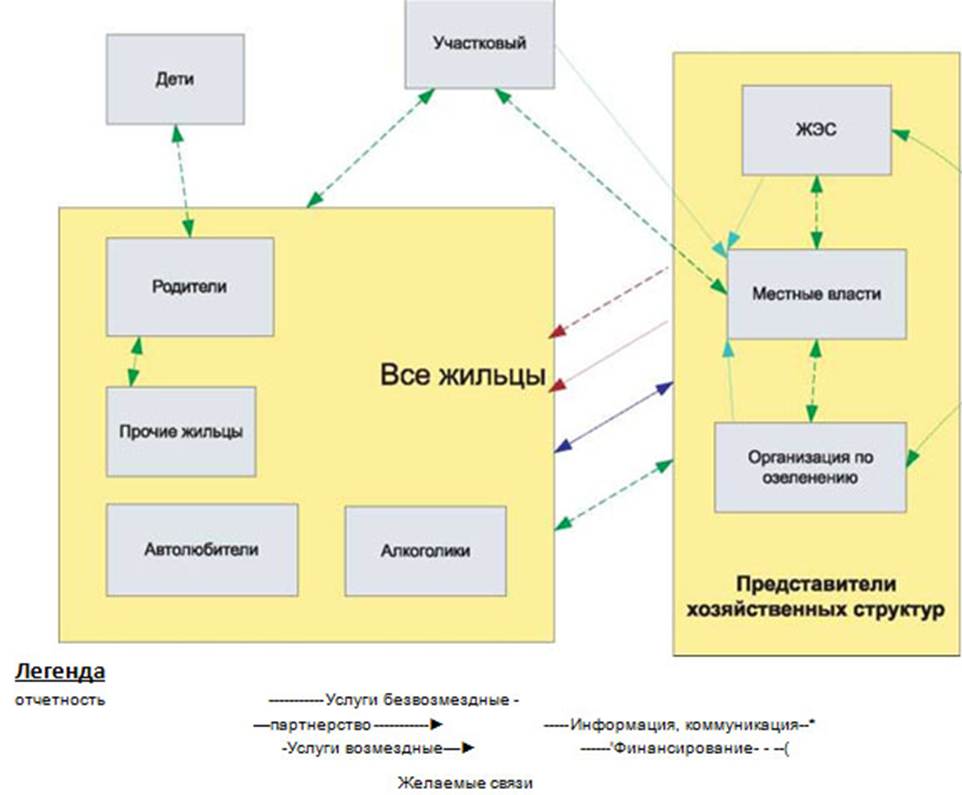STEP 1: STAKEHOLDERS ANALYSIS
These are all those people, groups of people, organizations, institutions that can be affected by the project being developed. Stakeholders are, first of all, representatives of the target group (that is, those who are targeted by the actions that will be carried out within the framework of the project), potential partners (with whose help the project can be carried out), opponents (the party interested in the project not realized), observers, higher organizations and authorities (if any), potential donors, the actual performers of the project ... If the planned activity affects the life, interests, work of someone or something - this party is interested.
WHY ANALYZE THEM?
A person reacts positively, negatively or neutrally to any change in the conditions of existence surrounding him, expressing his attitude to the subsequent changes. We have long been accustomed to some changes (change of seasons, for example) and treat them neutrally (“nature does not have bad weather”). Other changes may cause a violent reaction in us (suppose a neighbor with the best intentions, in your absence, decided to repaint your front door orange - after all, it’s prettier!). Likewise, any of the interested parties can react differently to the planned (by you) changes.
For example, in the case of a project to drill a well and provide water to a village, the target group may be enthusiastic about the idea of improving their living conditions.
On the other hand, the sanitary services may not have anything against the very idea of providing the village with water, but they will protest against drilling a well in the most convenient place - the quality of the water there does not meet the standards, and we will complicate their life with the need to prepare documents justifying the need to mothball the well. Our goal is to find a compromise in this situation. Therefore, it is necessary to assess how this or that interested party will react to the idea of taking certain actions: neutral, positively or negatively, how to make resistance to the project as low as possible, and assistance - as strong as possible.
HOW TO MAKE A LIST OF STAKEHOLDERS?
To explain what “stakeholders” are and why analyze them, we will give a purely “everyday” example.
Suppose we are preparing for the project "Purchase of food for the week". The list of stakeholders for this project can be quite large. He will not be limited to members of your family, whose interests, of course, must be taken into account. The list will include your employer (since the range of purchases directly depends on the amount of your salary), the store owner (setting the range of products) and even local authorities (issuing a license to sell certain goods and legislatively determining the opening hours of the store). Your neighbor, who is always aware of all the sales in the city, can also become a stakeholder as a source of information.
Some of the interested parties do not take any part in planning, but their interests will have to be taken into account (the opening hours of the nearest store and the fact that some products will not be there - for example, local authorities did not give its owner permission to sell fresh meat). The employer can probably be influenced by persuading you to raise your salary. The rest of the stakeholders become participants in the project, and you will spend some time discussing their needs (analyzing problems), making a list (setting goals), setting priorities (a bottle of your favorite beer is a desirable but not mandatory part of the list), calculating the funds available in the family budget, determination of the time, the route of the trip and other additional factors.
And now we are compiling a list of stakeholders for our project.
We answer the questions:
Who is the project activity aimed at?
Who will be involved in the project?
Who else can take part in the project?
On whom does the implementation of the project depend, who of the third parties will make key decisions related to the project (parent organizations, authorities, etc.)?
Who does the implementation of these decisions depend on?
Who is not interested in implementing the project? Who will openly or covertly resist the implementation of the project? (A common wording of the question: "For whom may the project pose a threat?")
Help, advice of what experts on certain (narrow) issues may be needed when organizing a project?
What organizations, groups of people, individuals can influence the project directly or indirectly? Define their intended roles.
Describe the target groups (gender, age, income, place of work, specialty, etc.) and analyze the effect of the planned activity on individual parts of these groups.
For example, activities related to the AIDS program assume a target group of both sexes who are of reproductive age (approximately 16 to 40 years old). If you are targeting adolescents from 16 to 20 years old, then first of all their actual interests and needs should be taken into account. It will be useful to know that consciousness and the ability to be responsible for their actions have not yet been fully formed, representatives of this part of the target group may not be familiar with the problem posed at all, besides, parents have a significant influence on them. Additionally, one must take into account that their level of income is low, and there is no permanent place of work. If you are targeting a group aged 20-25, then these are already largely formed independent individuals with a certain level of income and for the most part having a permanent place of work, family and children. They are very familiar with the problem under consideration and have their own views on how to solve it, which will significantly affect the nature of your activities compared to working in a teenage group. A similar analysis should be done for subgroups aged 25 to 30 and 30 to 40 years. If you intend to work with drug addicts, then it will be less dependent on the gender composition of the groups than if you intend to focus on the culture of sex life in your work.
How can representatives of the target group take part in the project, influence its implementation?
How differently will the project be perceived by men and women?
And now let's start considering the problem, by the example of solving which in this manual we will demonstrate the entire process of using the LSP in its entirety. As an example, a fairly common problem today was chosen: children cannot play in the courtyard of their house.
We in no way claim to be multifaceted in working out the problem and providing a standard algorithm for solving it, it was chosen only to demonstrate the use of LSP.
So, we define the stakeholders.
The activity is aimed at children and their parents.
The project will definitely involve tenants, house management (HES), an organization engaged in landscaping.
Also local authorities can take part in the project; perhaps the police will be the interested party.
Implementation of the solutions depends on the HHO and local authorities.
The project poses a threat to "holidaymakers" in the evening in the yard of lovers of the "green snake", as well as to motorists, whose cars are parked in the yard.
The information necessary for the development can be provided by local authorities, "fraternal" housing and communal services and residents of neighboring yards, who have already solved this problem.
Recorded the answers? We have on hand a list of interested parties. Now we will analyze them.
HOW TO DETERMINE POTENTIAL PROJECT PARTICIPANTS?
For each side, we answer the questions:

What is the specific interest in the problem that the project aims to solve? What are the reasons for this interest and the attitude (positive, negative, neutral) to the problem and the project itself?
What potential conflict situations could arise between stakeholders? How likely is a conflict to arise? How can he influence the project?
What negative reactions can the activities associated with the implementation of the project, solving the problem, cause? How likely is their occurrence? How can they affect the project?
What are the links between stakeholders, how can they be used? What are the possible ways of cooperation and resolution of possible conflicts?
What can an interested party do if it becomes a part of the project participants, at different stages of its implementation? Can she help with planning? Is it realistic that the stakeholder can actually play this role? Will she be able to get the job done?
We collect the obtained data in a table (see Table 2.):
Table 2. Stakeholder analysis table

In order to foresee all the nuances, you need to think over the answers to the following questions:
What actions need to be taken in order for the project goal to be achieved? What should be the roles of the participants in performing these activities?
What information do you need to have in order to design and implement a project (background information, organizational procedures, etc.)? Who can provide them?
What assumptions about the roles of stakeholders (target groups, potential partners and opponents, sympathetic observers, etc.) or their reactions should be made in order for the project to be successful?
For our example, the table might look like this:

Now, from the entire list, you can select those parties who are interested in the project being implemented and can provide, to a greater or lesser extent, assistance in its implementation. These are the potential participants in the project.
WHO SHOULD PERFORM ANALYSIS?
The most high-quality, complete, effective analysis can be carried out if the potential project organizer brings together representatives of all stakeholders and organizes a discussion of their attitude to the project and possible participation in it, the problems they face and expectations from the project (planned goals). As already mentioned in the chapter "Useful little things, or What should you pay attention to when working with a group?", The meeting can be led by the organizer himself, or you can invite an independent leader - a moderator, facilitator.
Representatives of the “target groups” must necessarily participate in the analysis. Why is this done?
First, your activity should not become addressless. By inviting representatives of target groups for discussion, you will understand whether your work is needed.
Secondly, most likely, you will learn many new details “at first hand” about the problem itself, about the expectations of the target group, you will be able to predict the reaction of its representatives at various stages of the project implementation and thus choose the necessary strategy for solving the problem.
Third, information about the expectations of the target group will help you understand what the real criteria for the effectiveness and evaluation of your project should be.
Fourth - and this is very important - if the target groups are not involved in planning, then this approach will lead to the creation of a so-called "service project": we come, do something for the target groups (who often do not understand why they need all this needed) and leave (since the resources are over). And the target groups go back to the “broken trough”, often confident that “someone made money” on them. If we talk about financing attracted from outside, then most often it is for this reason that the requirement for the participation of representatives of target groups in the planning process is a prerequisite for financing the project.
The ideal way to organize a discussion is to bring all stakeholders together and involve them in the analysis. However, it is often quite difficult to gather absolutely everyone for such a brainstorming session, so it is desirable that representatives of at least the main stakeholders be present. If, nevertheless, not all the main parties are represented, you can go for the trick: "appoint" some participants as "representatives" of the interested parties, asking them to express their views in accordance with this role. Naturally, one should take into account how competent such a participant is in this matter and how well he will fulfill his role.
The optimal group size for one facilitator (facilitator) is 14-16 people. If the group is smaller, then it will be difficult to consider the problem from different angles, if it is larger, there is a danger that during the discussion the situation will get out of control. If two facilitators are involved in the process, one of whom works with the audience, and the other monitors the logic and formulation of problems, then the group can be increased to 20-25 people. This number is the maximum for effective work and to ensure the active participation of all members of the group. A group of 30 or more people, as a rule, is either passive or poorly managed.
Imagine that during a discussion, one person takes 1-2 minutes for one statement, and since everyone wants to speak, it will take more than an hour to discuss one issue. Each participant will speak out 4-5 times, and the discussion time turns out, if not endless, then at least comes to this border. Since the group cannot work effectively for more than an hour and a half, in the end the thread of discussion will simply be lost: at the end, no one remembers "why we are here today." And it will be very difficult for the facilitator to keep the attention and keep the interactivity of such a large and diverse audience.
If you are lucky and there are quite a lot of participants, it is worth grouping them "by interests" and asking them to express those problems and judgments that are approved by all members of the group. Another option is to break the discussion into several stages, bringing together several groups of representatives of various stakeholders, organize the groups, conduct a preliminary analysis separately in each of them, and after a pause, organize a general discussion - perhaps not with the entire large group, but with representatives each of the subgroups. This way of organizing is not replaceable if there are too many interested parties or if it is physically impossible to gather everyone in one place at one time.
Also, on some issues, you can conduct a separate study with the involvement of experts, and then present its results during the general analysis.
In any case, it is necessary to organize the collection of information from stakeholders by all methods available in the available conditions. Otherwise, the organizers of the project may expect the problems already described above in the section Analytical and Planning Phases.
For our example: in order to conduct a stakeholder analysis, we must choose a date and time to discuss ways to solve the problem, invite representatives of the housing department, an organization dealing with landscaping, a district inspector, post announcements or otherwise notify residents.
WE BUILD A SCHEME FOR STAKEHOLDER ANALYSIS
What it is? This is a diagram that demonstrates all the parties interested in the project, as well as the existing and desired relationships between them. The diagram clearly describes the current situation.
What is it for? When we have a detailed picture of the relationship between stakeholders, it will be easier for us to describe the problems that will be solved during the development of the project and which are likely to be faced in the implementation of the proposed activity. The diagram will be the basis for the problem analysis.
Leading role. Another role of the schema is to restrict non-analysis statements. When the participants have a conversation, utterances can sprinkle like a cornucopia. The presence of the scheme will help to get the discussion back on track. The facilitator may ask heated participants questions such as: "What are the problems from the perspective of this or that stakeholder?", "Which stakeholder does the statement refer to?", "What problems do you see with this connection?"
So, having previously read the chapter "Useful little things, or What should you pay attention to when working with a group?", Let's get started.
Let's choose the space where the stakeholder analysis scheme will be located. There should be a lot of space, it should be clearly visible to all participants in the discussion.
We write down the names of all interested parties on the cards. For different groups, you can choose different card colors or a different marker color. But remember that at least 2 colors - for problems and for goals - will need to be reserved: red or yellow for problems, blue or green for goals.
We place them on a prepared surface - a board, a wall, a large sheet of paper will do. In the center - you, your organization or project, along the edges - cards representing stakeholders.
At the same time, we try to group the cards according to various criteria: representatives of target groups, alleged performers, permanent or presumptive donors, higher organizations, public institutions, representatives of local authorities, potential partners, colleagues, friends, enemies, sources of information covering the activities of the organization, etc. ... This list is not complete, depending on the specifics of your activity, the characteristics of the planned project and other factors, it can change significantly. The main thing is to follow the logic in the design of the scheme.
We denote the relationship “a group of interested parties (or a separate interested party) - you / your organization / project”. In the process, we determine the direction of communications: for example, if your organization is obliged to provide a report on the implementation of a project to a superior organization, then the communication line is directed from "you to her."
We denote the links between groups of stakeholders (or individual stakeholders). We also determine the direction of these connections.
To do this, you need to group the same type of links between stakeholders / groups or between stakeholders / groups and you / your organization / project. First, you need to decide what types of ties will be present: partnership, reimbursable assistance (in exchange for money / services / etc.) and gratuitous, communication, information, conflict, reporting ... You also need to determine the desired ties (which you would need and useful, but they are not currently available). Do not get carried away with this process unnecessarily - the number of types of connections should not be more than 10.
Now we need to take a set of several colored markers / felt-tip pens and draw a “legend” at the bottom (side, top - as you like) of our scheme, like a map. We assign a different kind of relationship to each color. If the colors are over, and the list is not yet exhausted, remember that the line can be different, for example, the blue solid line may indicate partnership, and the blue dotted line - funding.
Important! When constructing a diagram, not planned, future, but actual, existing connections are indicated.
Now, looking at the diagram, let's think about how strong the ties between stakeholders are, how often they communicate with each other, how strong their influence on each other is. We cut out the strongest bonds with thicker lines.
We try to show basic connections and not show obvious or irrelevant ones. For example, you should not focus on clarifying hierarchical relationships between structural units of stakeholders grouped together (for example, authorities), if this is not essential for the project. Also, it is not necessary to separately emphasize the fact that the “financing” relationship implies a “reporting” feedback.
You should strive to ensure that the diagram of everyday life is visual. Probably, for this you will have to move the cards, once again think about how to group the interested parties, remove obvious connections. Otherwise, instead of a diagram, we can get a useless "web" of cards and numerous, at first glance, chaotic connections between them. Analysis based on such a scheme in the future will not only be difficult, but impossible due to the abundance and high density of elements.
Figure 2. Example of a Non-Visual Stakeholder Analysis Chart

Figure 2 provides an example of a non-descriptive stakeholder analysis diagram for our example. Compare it with the diagram shown in Figure 3, and rate the clarity and convenience of the analysis in the case of building one or another option.
Figure 3. Example stakeholder analysis framework

So, the circuit is ready.
Let's summarize the theoretical knowledge gained.
Who is doing the analysis?
A group consisting of representatives from all parties affected by the project activities.
What do we get as a result?
List of interested parties.
Revealing their interest and attitude (positive, negative, neutral) to the problem to be solved by the project, identifying potential conflict situations.
A list of potential project participants, a description of their expected roles and the benefits that they can bring at different stages of the project.
An outline of existing and desirable relationships between stakeholders.
 Discounted payback period
Discounted payback period Methodological aspects of project management
Methodological aspects of project management Scrum development methodology
Scrum development methodology